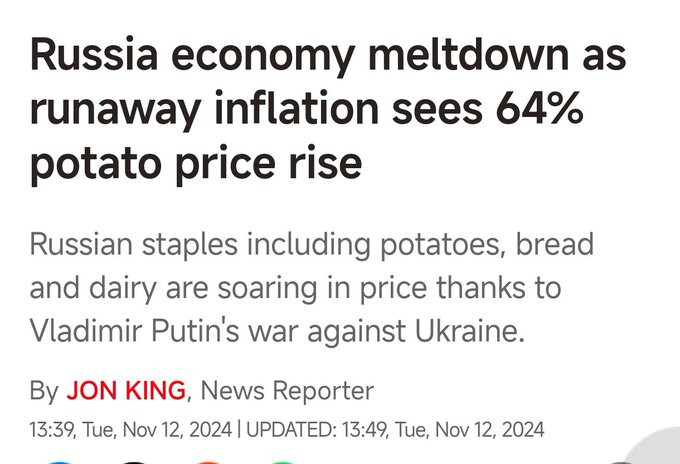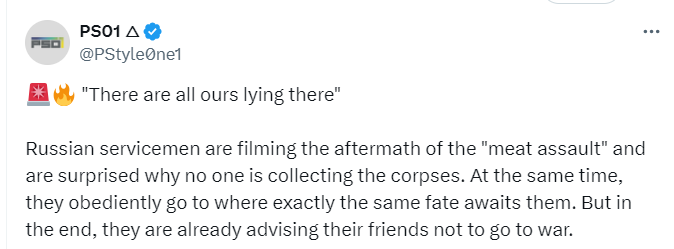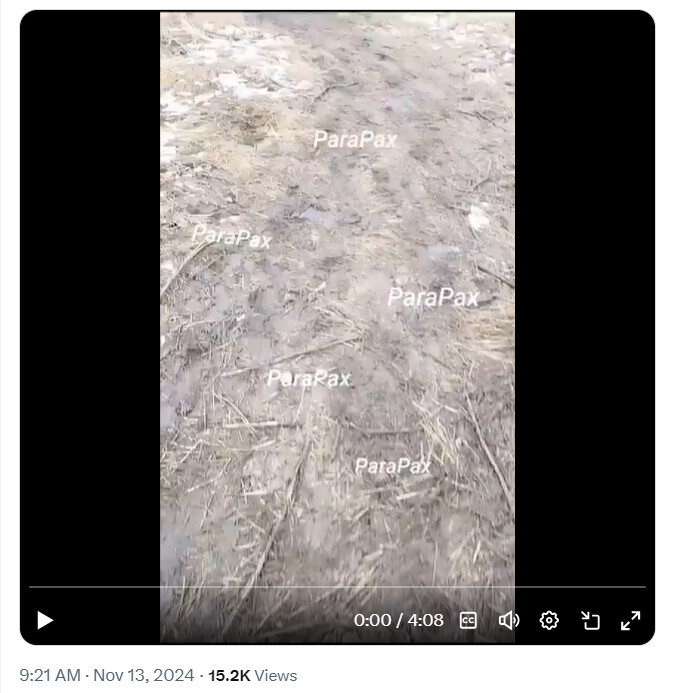IDK whether it’s unique to Russia, but it amazes me how quickly the Russian Orthodox Church, part of Imperial Russia abolished with the Revolution, regained its role as part of the system of governing in Russia after the collapse of the Soviet Union.
According to the Pew Centre and other studies, there were three waves of identification as card carrying members of the Russian Orthodox Church (not necessarily practising their religion). In 1991, the number of adherents was estimated at 31%. By 2008 , an estimated 72%. During this period, other religions had a slight increase, then levelled off.
The Russian Orthodox Church has a special status in Government and is a powerful tool for weaponising populist Nationalism .While Western Europe moves away from State religion as a Nationalist form of control of the population , Russia has gone in the other direction.
Trump can keep flooding Ukraine with better weapons to mince Russia’s frontline while also sending the country broke. Russia is approaching breaking point. By this time next year, they could have potentially lost 1% of their population to combat, all young men. Pair this with an absolutely cooked economy and you’ll have Putin’s head on a stick in no time.
Trump will just claim it’s taking longer than projected to clean up somebody else’s mess. He doesn’t care about campaign promises at all. How much of that wall was built, and how much of it did Mexico pay for?
Well, Putin learned the lesson well: “Religion is the opiate of the masses” and he is using it to full effect; instead of banning, he co-opted it.
Exactly!
Most countries have the good sense to separate state from religion. The problem we have is that religion, religious leaders, and religious zealots hate the position of no political say, and so infiltrate politics by all means available so to bend policies to their religion’s outlooks and beliefs.
Same title by economic historians, taught in Universities at two different times.
Religion and the Rise of Capitalism, by Tawney, England, 1926
Religion and the Rise of Capitalism, by Benjamin Friedman, US, 2021.
Then there is the aftermath of the French Revolution, when the clergy never regained its role as the First Estate, the Fifth Republic going to extremes as a secular society in banning all forms of identification as a Muslim in public roles.
Meanwhile, back in Russia, the opposite….
But surely Europe can do this? [quote=“user_name, post:4474, topic:33120”]
keep flooding Ukraine with better weapons to mince Russia’s frontline while also sending the country broke.
[/quote]
Yeah, I think it will happen regardless of whether the US in involved or not. I think the US will stay involved though.
The Baron of Bomberblitz is doing same to us.
There’s a particular problem facing Ukraine civilians and civilian resilience.
The US is the largest donor to the UN delivery of humanitarian aid, on the ground and via refugees ( including the internally displaced).
If the US goes down the path of defunding UN humanitarian aid in its various forms ((including coordination with NGOs) it would be adverse to civilians in Ukraine, at a time when those in the front line are losing retail access to basic food with shops closing. The WFP has moved into supplemental help with mobile baking ovens, dough kneading equipment etc, to enable bakeries to supply bread.
Europe don’t have anywhere near enough artillery manufacturing capability to meet UA’s needs. This is one of the big issues - none of the combined NATO manufacturing capacities are enough, even including USA.
Europe pledged to deliver 1m shells over a year and fell far short, I think it was something like 800k?
USA were at 14k shells per month. Currently:
The service has set a target of producing 100,000 artillery shells per month, but Army officials have shared it has fallen slightly behind schedule. Even so, the Army is now producing 40,000 shells a month, Army Secretary Christine Wormuth said at the Defense News Conference last month, adding that the plan is to reach 55,000 shells a month by the end of the year.
So they are now at 480k per year, aiming to get to 660k.
Collectively, the west is producing around 1.3m per year
UA has stated that they are aiming for 10,000 PER DAY, but using around 3-5000 per day. So that is 1-1.8m per year. If the USA stops supplying, then that is a massive hole that can’t be filled elsewhere.
Reports are around that suggest NK have provided 3m shells, some suggest 8m but that seems nuts. That is on top of RU production. So RU probably have a 4:1 advantage in artillery.
The loss of USA supplies would be a massive problem, UA really need the US production lines to keep pumping out shells.
Compounded by individual European countries stepping up their own national rearmament in the event that Russia extends its War beyond Ukraine.
all those numbers might be close to reality, but I can’t accept a tinpot dictator with an economy now smaller than Oz can take on and defeat Europe+Ukraine.
I understand that Europe lacks unity, but something is awry.
Banzai!
Russia Resorts to Banzai Attacks in Kursk to Retake Ukrainian-Held Areas
Story by Kathrine Frich
• 2h
Russian forces in the Kursk region of western Russia have intensified attacks on Ukrainian positions, using “banzai-style” assaults.
Japanese Inspired
These tactics involve direct, high-casualty attacks aimed at overwhelming Ukrainian defenses.
The term “banzai attack” originated in World War II, when Japanese soldiers charged enemy lines in large waves, prioritizing aggressive advances despite high casualties.
Russian forces seem to be employing a similar approach in Kursk, according to Ziare.
In recent reports, Russian infantry and paratroopers, with North Korean reinforcements, have repeatedly assaulted Ukrainian positions, determined to regain territory captured by Ukraine earlier this year.
Drive Ukraine From Kursk
Vadim Misnik, spokesperson for Ukraine’s “Siversk” tactical operations group, confirmed that Russian and North Korean troops are attacking Ukrainian lines in intervals of 10 to 15 minutes.
According to Misnik, these continuous assaults are intended to drive Ukrainian forces from Kursk before the U.S. presidential transition in January.
Analysts believe that Russia aims to strengthen its negotiation position in potential peace talks by reclaiming ground.
Currently, the Kremlin has amassed around 45,000 to 50,000 Russian and North Korean soldiers in Kursk. This force is supported by frequent drone and artillery strikes, intensifying pressure on Ukrainian defenses.
The Ukrainian brigades stationed in Kursk have reported relentless attacks, including assaults by armored vehicles and infantry units.
Misnik noted that Russian forces often begin their attacks using armored vehicles but switch to infantry groups after these vehicles are destroyed.
According to Misnik, the high frequency of Russian attacks signals Moscow’s willingness to endure significant losses to achieve its goals.
Drone operators have reported sighting Russian tanks, infantry fighting vehicles, and small groups of soldiers advancing steadily despite casualties. Although Ukraine’s defense has held strong, the constant pressure is stretching its resources.
Ukrainian intelligence has indicated that Russia may attempt a wider offensive in the region, potentially pushing further westward toward Sumy.
This would allow Russia to regain strategically significant positions before any ceasefire agreements could be established.
That’s why it’s so unsustainable for Russia. If the West keeps throwing money at this for another year, Putin is toast. (or alternatively presses the big red button) They’re suffering 10-1 losses and cooking their economy in the process. It’s so dire that they’re looking to NK for help.

Putin managed to fireproof Russia from import dependence on food staples, actually profiting from sanctions by introducing counter sanctions for import substitution…
Some food spikes have been manageable in affordable access to food in plentiful supply, while the economy has benefitted from trade in basic food exempted from sanctions.
But with the departure of all foreign suppliers and multinationals like the Cargills from a presence in the Russian food chain, the Kremlin’s capacity to use price controls on the oligarchy to maintain supply may have weakened, as the domestic food supply chains become even more concentrated.
Putin’s power base of the Oligarchy may weaken if he is forced to take them on to preserve his power base with the voter of supply of basic agricultural products.
If potatoes are getting more expensive, then vodka is getting more expensive.
The Russian population can seemingly tolerate a lot of crap, but that will almost certainly tip things over the edge.
Fortunately orange man will save the day for Putin
Luckily, South Korea is a powerhouse military arms producer. See Poland buying heaps of gear from them.
There is a catch, SK law forbids them to sell to countries in an active war. I wonder if the law is changed because of the NK involvement?

